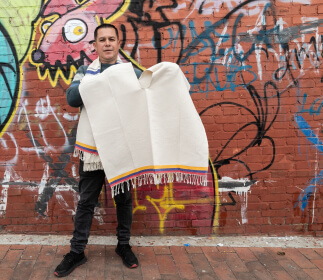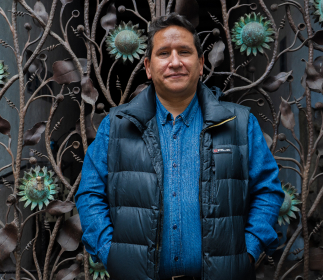José Alfredo Manzano
Workshop: Dardo
Craft: Basketmaking and woodwork
Trail: Bogotá Route
Location: Bogotá, Bogotá
SCHEDULE YOUR VISIT
Carrera 94b # 129c 48 Bogotá
3138147518
josemanzano.osma@gmail.com
@dardoartesanias
José never imagined he would find his true calling in craftsmanship. For many years, his life was devoted to a military career, reaching the rank of sergeant with the potential for further advancement. However, the war confronted him—or rather, the decisions made because of the war—and he chose to step aside. He didn’t feel he could continue following orders he didn’t believe in. This, of course, led to a profound emotional shift. Concerned for him, his sister suggested he try something radically different and told him about the Santo Domingo School of Arts and Crafts. Perhaps working with his hands would help him find his life’s meaning again. And she was right. It was 2012. The moment he walked into that historic building in downtown Bogotá and saw the wood, he felt a call he hadn’t felt in a long time. And working alongside woodcarver Yesid Robayo reignited his excitement for having a mentor.
He had discovered a passion. Now he needed to find a way to be true to himself in the craft of carving. His environmental commitment extends beyond being a vegetarian and fighting animal cruelty; he is deeply affected by waste, which makes him extremely rational in his consumption. This presented challenges in woodcarving since wood is not an infinite resource, and he felt that much of it was wasted. He also noticed a certain vanity among some students, who arrived with beautiful but inaccessible pieces of wood, almost like predators. This motivated him to study various methods and techniques to make his emerging interest into a sustainable craft.
He found this in laminated wood after countless hours in the library and a fascination with Japanese and European design schools. This technique uses pressed material that can be bent to create pieces with significant movement. His tools: a ruler, a scalpel, and a woodworking press. With African sapeli wood, he found a medium he could truly connect with. The material’s economy resonated with him, offering a formal exploration that posed many creative challenges. By bending the wood, he began producing bowls and lamps that started to stand out in the artisan market; his participation in fairs and interest from specialized media confirmed this. He then sought to explore new materials and returned to another craft that had caught his attention when he first arrived at the School: weaving. He was also intrigued by fique, so he began weaving and creating furniture that combined both techniques.
He works with dyed material from the expert hands of Patrocinia Pimienta in Curití. As we talk, he weaves. His love for it is palpable. He knows working with fique is tough because it’s not a soft material—he talks about the calluses, tendinitis, and wounds on his hands. Yet, he doesn’t complain; instead, he finds pure harmony in it. These marks on his skin give him purpose and restore the sense he lost for so long. He places his trust in beauty, which, for him, is his greatest purpose. This purpose is embodied in the name of his brand: Dardo, in homage to this endemic Pacific frog, threatened by mining, illegal trafficking, and deforestation, yet surviving as the most poisonous species in the world. There’s something in its resilience that calls and guides him. Today, he dreams of reaching the realm of art with his work. And if we look at his goals—first, to attend Expoartesanías; second, to be featured in a magazine; and third, to win an award—he’s making excellent progress. The first two have been achieved, and he was nominated for the prestigious Loewe Craft Prize for the third. Not bad at all. And given all that lies ahead, it’s clear he has found his purpose.
Craft


















Artisans along the way
Artisans along the way
No puede copiar contenido de esta página








































































